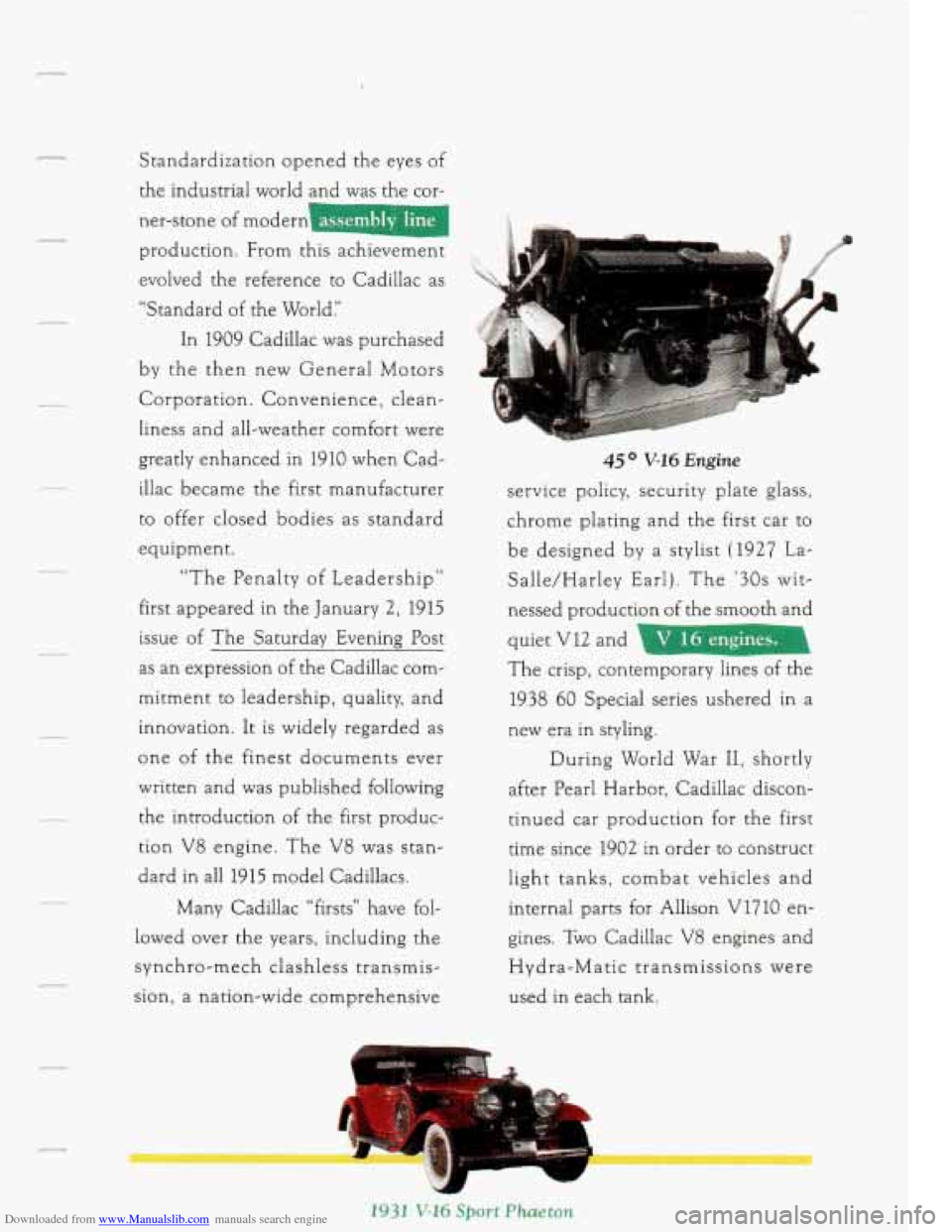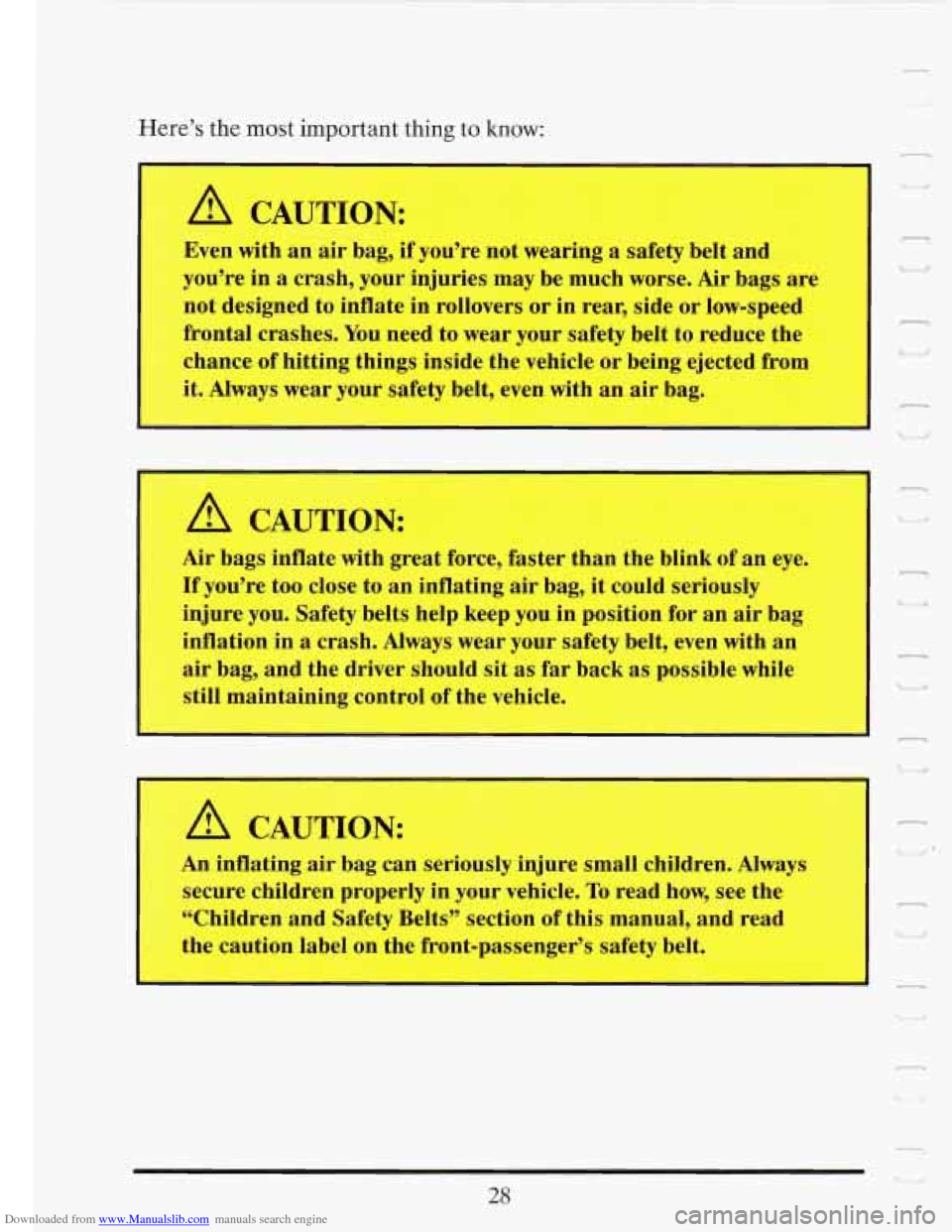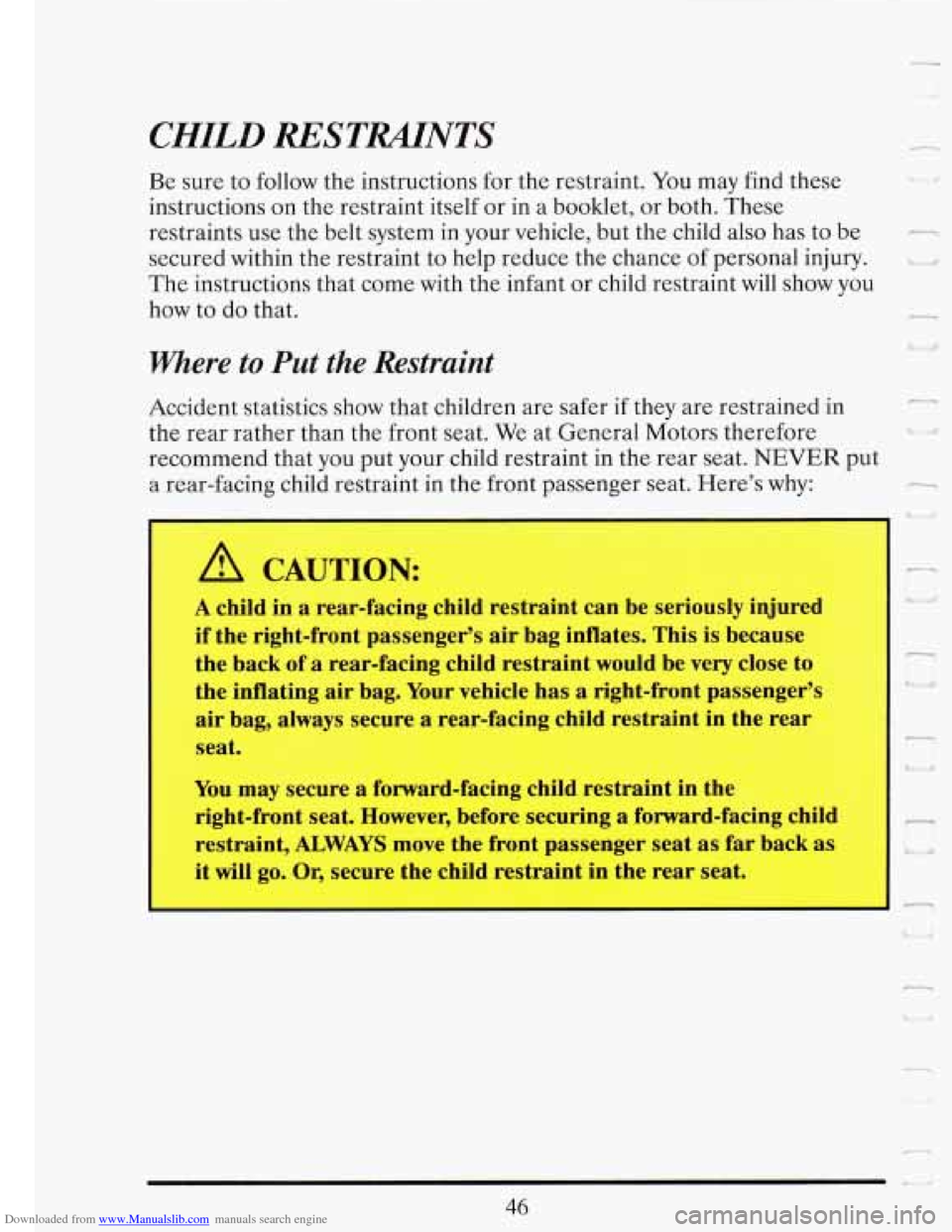Page 7 of 386

Downloaded from www.Manualslib.com manuals search engine Standardization opened the eyes of
the industrial world and was the cor-
ner-stone of modern
production. From this achievement
evolved the reference to Cadillac as
“Standard of the World.”
In
1909 Cadillac was purchased
by the then new General Motors
Corporation. Convenience, clean-
liness and all-weather comfort were
greatly enhanced in
1910 when Cad-
illac became the first manufacturer
to offer closed bodies as standard
equipment.
“The Penalty of Leadership”
first appeared in the January
2, 1915
issue of The Saturday Evening Post
45 O V-16 Engine
service policy, security plate glass,
chrome plating and the first car to
be designed
by a stylist (1927 La-
Salle/Harley Earl). The ’30s wit-
nessed production of the smooth and
quiet
V12 and 1-w ~ V 16 engines. - -
as an expression of the Cadillac com-
mitment to leadership, quality, and
innovation.
It is widely regarded as
one
of the finest documents ever
written and was published following
the introduction of the first produc-
tion
V8 engine. The V8 was stan-
dard in
all 1915 model Cadillacs.
Many Cadillac “firsts” have fol-
lowed over the years, including the
synchro-mech clashless transmis-
sion,
a nation-wide comprehensive The
crisp, contemporary lines of the
1938 60 Special series ushered in a
new era in styling.
During World War
11, shortly
after Pearl Harbor, Cadillac discon-
tinued car production for the first
time since
1902 in order to construct
light tanks, combat vehicles and
internal parts for Allison
V1710 en-
gines. Two Cadillac
V8 engines and
Hydra-Matic transmissions were
_i used in each tank.
Page 42 of 386

Downloaded from www.Manualslib.com manuals search engine Here’s the most important thing to know:
I A CAUTION:
L
I
Even with an air bag, if you’re not wearing a safety belt and
you’re in a crash, your injuries may be much worse. Air bags are
r-
not designed to inflate in rollovers or in rear, side or low-speed
hntal crashes. You need
to wear your safety belt to reduce the
chance
of hitting things inside the vehicle or being’ejected from
it. Always wear your safety belt, even with an air bag.
A CAUTION
Air bags inflate with great force, faster than the blink of an eye.
If you’re too close ta an inflating air bag, it could seriously
injure you. Safety belts help keep you in position for an air bag
inflation in
a crash. Always wear your safety belt, even with an
air bag, and the driver should sit as far back as possible while
still maintaining control
of the vehicle.
A CAUTION:
An inflating ais bag can seriously injure small children. Always
secure children properly in your vehide. To read how, tee the
“Children and Safety Belts” section
of this manual, and read
I the caution label on the front-passenger’s safety belt.
28
Page 60 of 386

Downloaded from www.Manualslib.com manuals search engine CHILD RESTUNTS
Be sure to follow the instructions for the restraint. You may find these
instructions on the restraint itself or in a booklet, or both. These
restraints use the belt system in your vehicle, but the child also has to be
secured within the restraint to help reduce the chance of personal injury.
The instructions that come with the infant or child restraint will show you
how
to do that.
Where to Put the Restraint
Accident statistics show that children are safer if they are restrained in
the rear rather than the front seat. We at General Motors therefore
recommend that you put your child restraint in the rear seat.
NEVER put
a rear-facing child restraint in the front passenger seat. Here’s why:
n
A CAUTION:
A child in a rear-facing child restraint can be seriously injured
if the right-front passenger’s air bag inflates. This is because I
the back of a rear-facing child restraint would be very close to
the inflating air bag. Your vehicle has
a right-front passenger’s
air bag, always secure
a rear-facing child restraint in the rear
seat.
You may secure a forward-facing child restraint in the
right-front seat. However, before securing
a forward-facing child
restraint,
ALWAYS move the front passenger seat as far back as
it will go. Or, secure the child restraint in the rear seat. Lj’ ri
46
Page 62 of 386
Downloaded from www.Manualslib.com manuals search engine Top Strap
If you need to have
to put
it in for you.
can tell you how to
If your child restraint
has a top strap, it
should be anchored.
I an anchor installed, you can ask your Cadillac dealer
If you want to install an anchor yourself, your dealer
do it.
IC-
Vehicles first sold in Canada have child restraint anchor Dracket hardware
in the glove box, along with instructions for installing it. This should be
used only with a child restraint, and only to secure a child restraint at the
center rear seating position. Additional anchor brackets for child
restraints at one or both
of the rear outside seating positions are available
at Cadillac dealerships in Canada. ph
,.
Securing a Child Restraint in a Rear Outside Position
n -1
Page 63 of 386
Downloaded from www.Manualslib.com manuals search engine You’ll be using the lap-shoulder belt. See the earlier section about the top
strap if the child restraint has one.
-
1. Put the restraint on the seat. Follow the instructions for the child
restraint.
2. Secure the child in the child restraint as the instructions say.
3. Pull out the vehicle’s safety belt and run the lap part through or
2_ around the restraint. The child restraint instructions will show you
how. Tilt the latch plate to adjust the belt if needed.
See if the shoulder belt would
go in front of the child’s face or neck. If
so, put it behind the child restraint.
49
4. Buckle the belt.
Make sure the
release button
faces upward or
outward,
so you’ll
be able to
unbuckle it
quickly
if you ever
need to.
Page 64 of 386
Downloaded from www.Manualslib.com manuals search engine 5. To tighten the
belt, pull up on
the shoulder belt
while you push
down on the child
restraint.
6. Push and pull the
child restraint in
different
directions to
be
sure it is secure.
n
LP
To remove the child restraint, just unbuckle the vehicle’s safety belt and
let it go back all the way. The safety belt will move freely again and be
ready
to work for an adult or larger child passenger.
ri
c. .A
50
Page 65 of 386
Downloaded from www.Manualslib.com manuals search engine Securing a Child Restraint in the Center Rear Seat
Position
You'll be using the lap belt. See the earlier section about the top strap if
the child restraint has one.
1. Put the restraint on the seat. Follow the instructions for the child
restraint.
2. Secure the child in the child restraint as the instructions say.
I.
3. Pull the lap belt
all the way out
without stopping.
51
c_ 4. While holding it out, run the belt through or around the child
restraint. The child restraint instructions will show
you how.
Page 67 of 386
Downloaded from www.Manualslib.com manuals search engine 7. Push and pull the
child restraint in
different
directions
to be
sure it is secure.
To remove the child restraint, just unbuckle the vehicle’s safety belt and
let it go back all the way. The safety belt
will move freely again and be
ready to work for an adult or larger child passenger.
Securing a Child Restraint in the Right Front Seat
Your vehicle has a right-front passenger’s air bag. NEVER put a
--- rear-facing child restraint in this position. Here’s why:
53